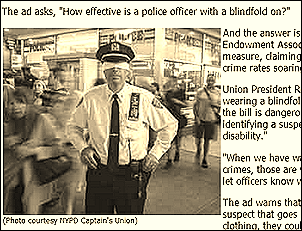 Finishing up some reading that I will be posting on soon, but I came across this in my work feed:
Finishing up some reading that I will be posting on soon, but I came across this in my work feed:NYPD unions say bill would blindfold officers, "It will ban cops from identifying a suspect's age, gender, color or disability" — or risk being sued for profiling"
I have to say that this is disappointing on many levels, even the idea that someone should withhold information that could lead to the arrest of an assailant or criminal due to accusations of racism or, when that charge is leveled at law enforcement, "profiling."
My take:
Every victim or witness should make every effort to give as complete and accurate a description as possible of everything that was involved in the commission of a crime. If it's early evening, and you see three guys in light blue shirts and faded jeans breaking into a business across the street with a white Ford F-150 parked out back, describe exactly what you saw. Those are the facts! If you happen to notice that all three are Hispanic males wearing light blue shirts with faded jeans, one is approximately 5-foot, four inches, the other two about average height, and one had a red bandana in his back pocket, and there was a white F-150 running with NJ plate XXXXXX, then that's what you should report.
In a previous life, I did some part-time police dispatching (rather amateurishly, in fact), and was trained to get from victims, then provide to my officers all descriptors that could identify a perpetrator, so I did. If you don't the chances of them getting the wrong guy (whoops, I just profiled!) go way up, and it could be you that becomes a victim, and the real criminal may never get caught.
So how do you be a good victim?
What should you provide if you witness, or are the victim of a crime? Everything. Some suggestions:
First of all, when you call 9-1-1 (in the US), make sure you give you number, in case you get disconnected, and your location. Not every dispatch center can obtain that information all of the time - systems fail, and can be inaccurate.
Of the subject (as accurate as you can, and tell the authorities if it's a guess or estimate):
- Sex
- Race/ethnicity
- Age
- Height
- Weight
- Build
- Hair color (or baldness)
- Facial hair
- Any distinguishing scars, marks, or tattoos
- Head covering/hat
- Shirt type and color
- Pants type and color
- Shoes
- Anything else that could narrow it down, like missing teeth/eyes, limps, language, etc.
Of the situation and environment:
- Where did the crime occur?
- What happened? Be succinct, but complete.
- Is the danger still present? Is there a person there with a knife/gun or other weapon? Is the fight still going on?
- How many people are involved?
- What time did it happen?
- Which way did they go?
- What kind of vehicle were they driving? Did you get a plate number?
Please don't think I am making light of, or minimizing racial profiling. I am not. All factors must be included in reporting a crime, both to protect the innocent, and to catch criminals.
Disagree? Agree? Please tell me what you think, and why in the comments.
____
Like this post? Subscribe to our feed or by email and you won’t miss a thing.
All original material is copyright of their respective authors.
All rights reserved. Permission must be obtained before use. Copyright 2013

1 comment:
nice blog. I agree with you.
please visit-
http://www.pacificsports.com.au
Post a Comment